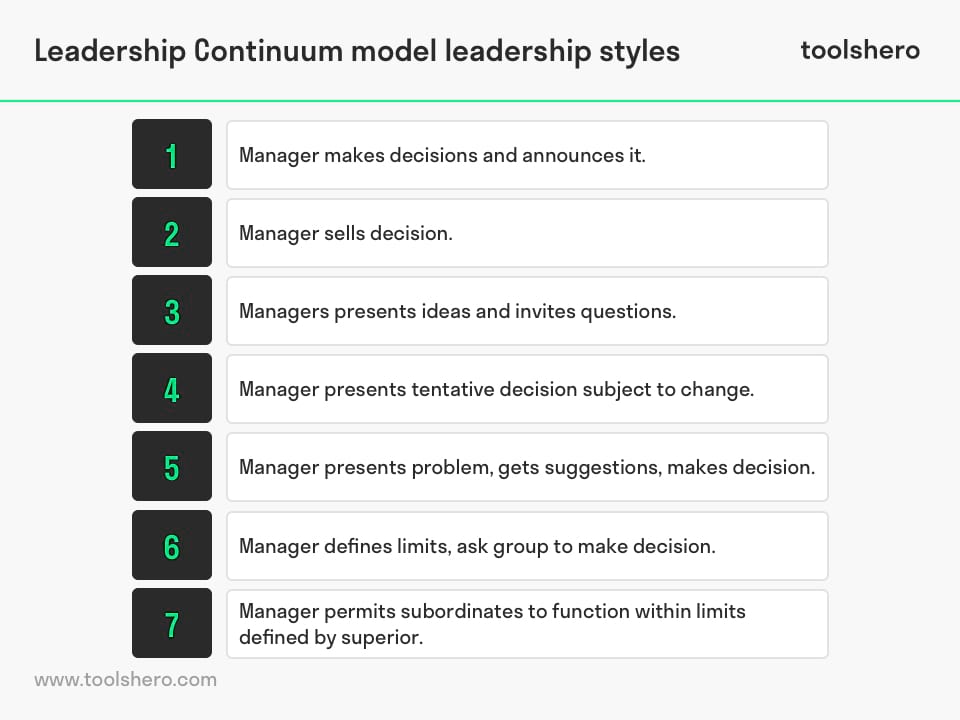Tannenbaum-Schmidt Leadership Continuum Model

Tannenbaum-Schmidt Leadership Continuum: this article provides a practical explanation of the Tannenbaum-Schmidt Leadership Continuum modelwhich was developed by Robert Tannenbaum and Warren H. Schmidt. In addition to explaining what the model is, this article also highlights the leadership styles and a final conclusion about this theory. After reading it you will understand the basics of this leadership theory. Enjoy reading!
What is the Tannenbaum-Schmidt Leadership Continuum model?
The Tannenbaum-Schmidt Leadership Continuum model is a leadership model that is designed by Robert Tannenbaum and Warren H. Schmidt.
It was first published in the Harvard Business Review in 1958. It won its popularity since then and it is today still a frequently used tool to identify and select the most appropriate leadership style for any situation.
The Tannenbaum-Schmidt Leadership Continuum model is a leadership model that shows the relationship between the authority of a manager and the freedom of its team.
According to the model, on one hand, leaders tell employees directly what to do without discussion, and on the other hand, leaders give their team complete freedom.
In the last case, where the manager gives total freedom to its employees, it is expected that the chance is high that the employees develop the business because of the stimulation of their creativity.
Both are one of the two extremes of the Tannenbaum-Schmidt Leadership Continuum model. In reality, it seldom occurs that a manager applies one of the two extremes leadership styles. Due to a broad spectrum of leadership styles in the Tannenbaum-Schmidt Leadership Continuum model and different personality traits of managers, leaders mainly have a leadership style that is somewhere in the middle of the Tannenbaum-Schmidt Leadership Continuum model.
Even if a leader solely tells his or her team what to do, the likelihood is high that there is also some room for discussion. And a leader who gives completely freedom to its team is many times a leader who trust the expertise of its team. But even in this scenario, when difficult decisions must be made, the manager is the final decision-maker.
The Tannenbaum-Schmidt Leadership Continuum model can be used to evaluate different leadership styles. It is not designed with the intent to point out the best leadership style. There simply is no best leadership style because every situation is unique.
In addition, managers are responsible for overseeing departments. Business success is dependent on every worker, but it is also depending on the leadership of the manager. This means that the manager should effectively make use of the human resources which can be done by, for example, delegating or giving freedom to the team.
However, the manager should understand that if an employee makes a mistake that has an impact on the organization, the manager will be held responsible because the employee performed a job under the manager’s authorization.
It is for this reason important for the manager to choose the most effective leadership style of the Tannenbaum-Schmidt Leadership Continuum model for every particular situation. A leader can have different leadership styles which are depended on the type of business and industry, and the particular situation.
It means that leadership styles may vary per occasion because every situation needs a different evaluation. This includes evaluating all factors that could help to identify the most appropriate leadership style such as the quality of the employees, the manager’s personality, and other situational factors that urge for urgency in decision-making.
Tannenbaum-Schmidt Leadership Continuum model leadership styles
The Tannenbaum-Schmidt Leadership Continuum model identified the following leadership styles:
- Manager makes decisions and announces it.
- Manager sells decision.
- Managers presents ideas and invites questions.
- Manager presents tentative decision subject to change.
- Manager presents problem, gets suggestions, makes decision.
- Manager defines limits, ask group to make decision.
- Manager permits subordinates to function within limits defined by superior.

Figure 1 – Tannenbaum Schmidt Leadership Model and Leadership Styles
1. Manager makes decisions and announces it
In this leadership style, the manager solely tells its team what to do. Based on the Tannenbaum-Schmidt Leadership Continuum model, there is in this case no team involvement because the leader typically sees the identified problem as an individual problem that needs to be solved by its team.
The solution is in addition only identified by the manager without discussion. This type of leadership style can be frustrating for the team if this is the standard type of leadership.
However, it can be useful if strict deadlines must be met, and when employees need to be trained or when they do not possess the right mix of qualities to perform a job effectively. It is for this reason again important to evaluate the previously described factors that help to identify the right type of leadership style.
2. Manager sells decision
This type of leadership style of the Tannenbaum-Schmidt Leadership Continuum model is concerned with persuading the team to agree with a decision that is made by the manager. In this case, the manager also makes final decisions for the team. However, the manager wants the team to understand why the decision is made.
It is at the same time important for the manager to explain what positive effects the decision will have on the team. In addition, it is essential for the manager to receive recognition for the decisions made because this improves the relationship between the employees and the manager.
3. Manager presents ideas and invites questions
It is in this leadership style important for the manager to involve the team with the decision. Although the decision is made by the manager, the employees have a chance to speak up and explain their thoughts. The decision will probably not change, but it is a perfect opportunity for both the manager and employee to see whether they understand the decision.
This enables the manager to identify who of its team is getting ready to get more responsibilities because of their critical thinking, and it enables employees to demonstrate its current professional thinking. Both will be beneficial for the future success of the organization.
Leadership Masterclass – Insights, Models and Application
4. Manager presents tentative decision subject to change
This type of leadership style of the Tannenbaum-Schmidt Leadership Continuum model is concerned with actively involving employees in decision making. The leader acknowledges that any problem is a group problem, and therefore, the employees should be able to influence the decision if good arguments are made.
However, many times the manager has already made an initial decision, but the decision can change after consulting with the employees. In this way, there is a high chance employees feel more valued and more belonged because they have the ability the influence decisions.
5. Manager presents problem, gets suggestions, makes decision
If a manager or leader adopt this type of leadership style, he or she actively involve all members of the department of the organization before a decision will be made. This means that the decision-making process is more team-centered. The manager presents the problem and request suggestions to solve it.
However, the employees provide input, but the manager still makes the final decision. The difference between the previously described leadership styles is that the problem is first discussed with the group before a decision is made.
Since this leadership style of the Tannenbaum-Schmidt Leadership Continuum model requires many inputs, it is expected that employees are highly skilled and possess over the right knowledge before they contribute to the decision-making process.
6. Manager defines limits, ask group to make decision
This leadership style gives more freedom to employees, but it additionally carries more risks for the leader. The manager, in this case, define the organizational problem with its employees.
The workers are next requested to come up with a solution without the involvement of the manager. It means that the manager has given authority to its employees to make decisions on behalf of the manager.
It is for this reason crucial for the manager to define the limits to which employees are allowed to make a decision with this type of leadership style of the Tannenbaum-Schmidt Leadership Continuum model because the manager remains responsible for all decisions made.
The boundaries will eliminate potential risks, and therefore, it is best to use this leadership style with highly experienced teams.
7. Manager permits subordinates to function within limits defined by superior
This type of leadership of the Tannenbaum-Schmidt Leadership Continuum model is one of the extreme types of leadership in which the manager gives complete freedom to the team.
In this case, the leader is also responsible for all decisions made but he or she encourages the team to identify and solve problems themselves instead of involving the manager.
Many times, the manager expects the team to research potential problems and take measures to mitigate risks. This type of leadership many times occurs in the top management of organizations because it enables them to design and execute the strategies of organizations.
Conclusion
The bottom line of the Tannenbaum-Schmidt Leadership Continuum model leadership styles is that the amount of freedom of employees is in correlation with the level of education and competencies.
Many times, the amount of freedom will increase with an increased level of trust and competencies. This also happens when employees get promoted to higher positions in companies.
Managers remain responsible for business activities under their authority. For this reason, they must accept all risks when tasks are delegated.
Because if a task is delegated, there is less control over the activity. It means that a leader should consider the extent to which they want to participate with the employees in order to realize successful business outcomes.
It’s your turn
What do you think? Are you familiar with the explanation of the Tannenbaum-Schmidt Leadership Continuum model? Have already evaluated your leadership style? Can you give your team completely freedom, do always have to them what to do, or is it somewhere in between? Do you have any tips or additional comments?
Share your experience and knowledge in the comments box below.
More information
- Karve, S. (2023). Leadership Masterclass – Insights, Models and Application. Retrieved 07/02/2024 from Udemy.
- Schmidt, W. H., & Tannenbaum, R. (1960). Management of differences. Harvard Business Review.
- Tannenbaum, R., & Schmidt, W. H. (1958). How to choose a leadership pattern (pp. 95-101). USA: Institute of industrial relations.
- Tannenbaum, R., Weschler, I., & Massarik, F. (2013). Leadership and Organization (RLE: Organizations): A Behavioural Science Approach. Routledge.
How to cite this article:
Zeeman, A. (2019). Tannenbaum-Schmidt Leadership Continuum. Retrieved [insert date] from Toolshero: https://www.toolshero.com/leadership/tannenbaum-schmidt-leadership-continuum-model/
Original publication date: 10/21/2019 | Last update: 09/02/2024
Add a link to this page on your website:
<a href=”https://www.toolshero.com/leadership/tannenbaum-schmidt-leadership-continuum-model/”>Toolshero: Tannenbaum-Schmidt Leadership Continuum</a>












